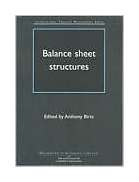|
||
• wydawnictwa polskie
• Zamów informacje o nowościach z wybranego tematu • kontakt
• Cookies na stronie |
BALANCE SHEET STRUCTURESBIRTS A.wydawnictwo: WOODHEAD , rok wydania 2001, wydanie Icena netto: Balance Sheet StructuresBalance Sheet Structures is a practical and comprehensive guide to balance sheet issues. The book begins by covering the financial theory necessary for an understanding of the debt versus equity issue and then focuses on real world issues by discussing answers to the questions
These questions are looked at through a series of case studies, mostly written by those who are responsible for the balance sheet structures they are living with. The book also aims to help the reader understand the interrelationship between debt and equity in terms of the overall value of the company and the impact on the company's cost of capital. It covers the various elements that make up the balance sheet, and the costs and benefits that attach to each and goes on to analyse the interrelationship between the business that the company is in, the maximisation of cash flows and the balance sheet that matches the business reality. Balance sheet structures is an invaluable and concise guide intended for a wide range of interested parties - treasurers, bankers, directors and students of business and economics. About the editor Anthony Birts is currently Teaching Fellow in Finance at the School of Management, University of Bath, UK where he is also Director of the MBA Programmes. He did his MBA at Manchester Business School and previously worked at the Bank of America NT & SA where he was Vice President of Global Payments. About the contributors Stephen J East is Finance Director of MEPC PLC and currently also Vice President of the Association of Corporate Treasurers having previously chaired its publications, programme and education committees. Michael McCallan is Vice President and Treasurer, Esselte AB, the Swedish global office supplies company. He is author of Re-engineering corporate treasury (ACT Business of Finance series) and is a contributor to Managing banking relationships (Woodhead Publishing Limited). Gary Crouch is a founder and Finance Director of the Avebury Group, which since its inception in 1997 has grown rapidly and now operates around 700 tenanted pubs throughout England and Wales. Anthony Stern is Director of Treasury at Bass PLC where he is responsible for treasury and banking matters covering more than ninety countries in which the group operates through its Inter-Continental and Holiday Inn hotels. Tim Owen is Director of Treasury at Cadbury Schweppes PLC, a company with a turnover of L4bn and a market capitalisation of over L8bn. Alan Clements is the Founder President of The Association of corporate Treasurers and has a distinguished business background having been Treasurer and a Main Board Director of ICI as well serving on several other boards: David S Smith Holdings (Chairman); MGN PLC (Deputy Chairman); Cable and Wireless; Granada; Trafalgar House (Chairman) and Guinness Mahon Holdings PLC. Contents 1. Debt versus equity 2. Setting optimum
debt/equity ratios: theory and practice 3. Elements of a group's
capital structure Case study: Michael McCallan
- Parentco PLC - L80 million, 7% convertible bonds 4. Developing a capital
structure: practitioners' approaches Case study: Gary Crouch -
Household Mortgage Corporation 5. The international
dimension Case Study 1: Anthony Stern -
Parentco: the financing of foreign subsidiaries Case Study 2: Tim Owen -
Financing the acquisition of Dr Pepper/Seven-Up 6. Dividends 7. Managing stakeholder
perceptions Moody's tool kit: a framework
for assessing hybrid securities 190 pages Księgarnia nie działa. Nie odpowiadamy na pytania i nie realizujemy zamówien. Do odwolania !. |


